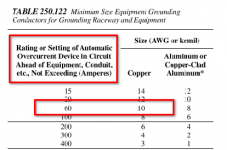wwhitney
Senior Member
- Location
- Berkeley, CA
- Occupation
- Retired
Sure it does. The following is a valid installation:250.122 does not care about MCA
28A MCA
40A MOCP and actual OCPD
No ampacity correction or adjustment required
#10 Cu ungrounded
#10 EGC
So now if the install uses #8 Cu instead of #10, the "ungrounded conductors are increased in size." 250.122(B) says you have to increase the EGC in size proportionately, so you need a #8 Cu EGC, unless you can invoke the exception.
Cheers, Wayne


